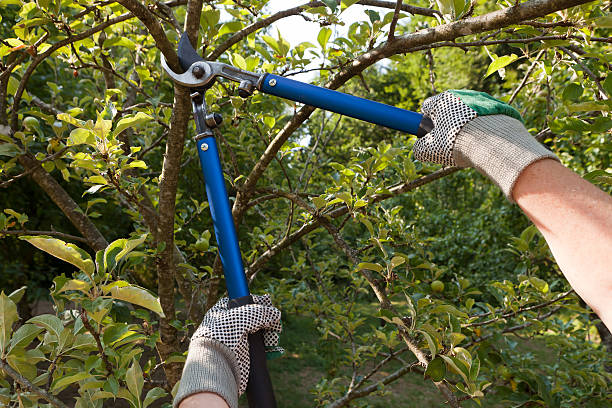
At Allen’s Tree Care, we believe healthy trees are the backbone of a beautiful landscape. One of the most effective ways to ensure trees thrive year-round is proper tree pruning. Whether it’s to remove dead branches, shape young trees, or prevent safety hazards, pruning plays a critical role in overall tree care. This guide will walk you through the essentials of tree pruning, when to do it, and how it benefits your property.
What is Tree Pruning?
Tree pruning is the practice of selectively removing certain branches or parts of a tree to improve its health, structure, and appearance. This process differs from tree trimming, which typically focuses more on aesthetics and size control. Pruning is more focused on long-term vitality and safety.
Why Tree Pruning is Essential
Pruning is not just about making trees look tidy—it’s about protecting their future. Here are a few important reasons why pruning is necessary:
- Removes dead or diseased limbs
- Reduces risk of property damage
- Improves air circulation and sunlight exposure
- Promotes healthy growth and structure
- Encourages flowering and fruiting in certain species
Types of Tree Pruning
There are several types of pruning methods, each designed for specific outcomes:
- Crown Cleaning – Removing dead, dying, or diseased limbs.
- Crown Thinning – Selectively removing branches to reduce weight and improve air flow.
- Crown Raising – Removing lower limbs to clear space under the tree.
- Crown Reduction – Reducing the size of the overall canopy while maintaining natural shape.
- Structural Pruning – Especially for young trees to develop a strong framework.
Each technique requires knowledge of tree biology and growth patterns to avoid causing long-term damage.
When is the Best Time to Prune Trees?
While pruning can be done year-round in emergency cases, certain times are more beneficial depending on the species and purpose:
- Late Winter to Early Spring: Ideal for most trees before new growth starts.
- Mid-Summer: Light pruning to remove unwanted growth or minor shaping.
- Fall: Not generally recommended as it may promote fungal growth.
Always research the species of your tree to determine the optimal time.
Tools Used for Tree Pruning
Using the right tools is key to a clean, safe pruning job. Common tools include:
- Hand pruners – Best for small branches under ¾ inch thick.
- Loppers – Used for branches up to 2 inches thick.
- Pruning saws – Designed for larger limbs.
- Pole pruners – Helpful for reaching higher branches.
Make sure all tools are sharp and sterilized to prevent disease transmission.
DIY or Hire a Professional?
While homeowners can handle small pruning jobs, large or high-up branches should always be left to certified arborists. Improper cuts can damage the tree permanently or pose serious injury risks. A professional has the expertise and equipment to manage pruning tasks safely and effectively.
Common Tree Pruning Mistakes to Avoid
Pruning the wrong way can do more harm than good. Here are a few common errors:
- Topping the tree – Removing the entire top leads to weak regrowth.
- Using dull tools – Results in jagged cuts that take longer to heal.
- Over-pruning – Can stress the tree and stunt growth.
- Cutting too close to the trunk – This damages the protective collar.
Proper pruning always respects the tree’s natural structure and growth habit.
Benefits of Regular Tree Pruning
Investing in scheduled tree pruning brings a wide range of benefits:
- Extended tree lifespan
- Reduced risk of falling limbs during storms
- Improved curb appeal and property value
- Enhanced safety around driveways and sidewalks
- Better fruit production in fruit-bearing trees
A tree that is regularly pruned is healthier, stronger, and more beautiful.
Frequently Asked Questions (FAQs)
Q: How often should trees be pruned?
Most mature trees benefit from pruning every 3 to 5 years. Younger trees may require more frequent attention during their formative years.
Q: Is there a difference between tree trimming and tree pruning?
Yes. Trimming usually focuses on aesthetics and controlling size, while pruning is about health, safety, and structure.
Q: Will pruning harm my tree?
Not when done properly. In fact, correct pruning can strengthen the tree and prevent disease.
Q: Can I prune trees in the summer?
Light summer pruning is fine, but avoid heavy cuts. Always avoid pruning during times of high heat or drought stress.
Q: Are there trees that shouldn’t be pruned in winter?
Yes. Some flowering trees (like cherry or dogwood) are best pruned just after they bloom to avoid removing flower buds.
Conclusion
Tree pruning is both a science and an art, requiring knowledge, timing, and precision. Whether you’re maintaining the shape of a tree, removing hazards, or promoting healthier growth, pruning should be part of your regular landscape care. For larger or more complex pruning tasks, always consider hiring a trained professional to ensure your trees thrive for generations to come.





